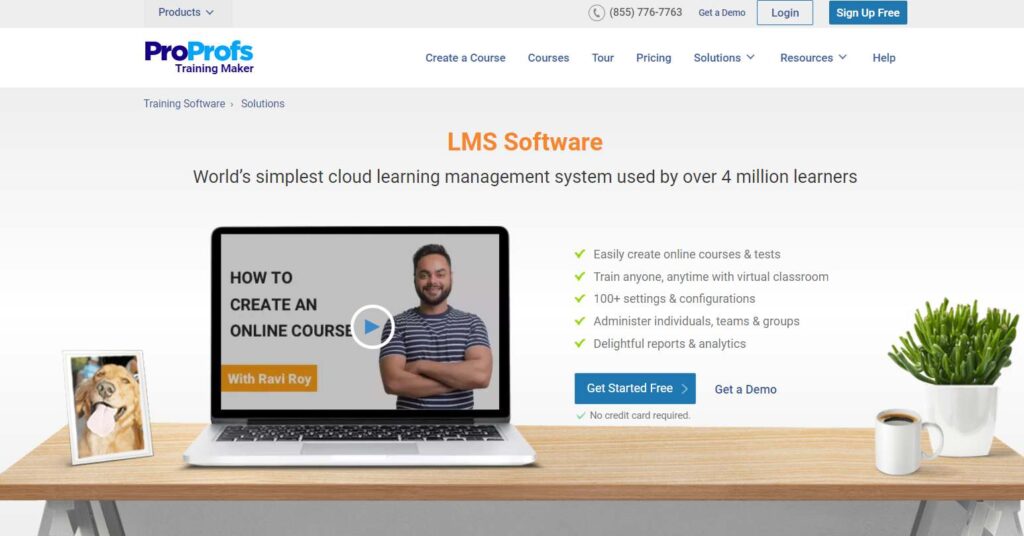Training manuals play a significant role in workplace learning, from new hire onboarding to the ongoing development of existing employees.
They help employees get acquainted with their roles and responsibilities, learn how to perform a task correctly and efficiently, and understand specific job-related instructions.
Employee training manuals also serve as a reference tool to find answers to important questions or seek guidance while performing job duties.
But today, most organizations have digitized their training manuals to ensure ease of creation, update, and access anytime, anywhere, and to protect them from possible loss. They have moved away from bulky and dog-eared handbooks to online resources, such as video tutorials, PDFs, and mini-courses.
So, for the purpose of this blog post, I’ll be focusing on training manuals in the online version.
Continue reading to find out all about training manuals, including how to create one for your employees.
How to Create a Training Manual for Employees
Whether you are creating an employee manual for the first time or the nth time, it always helps to follow the best practices. This will ensure it is comprehensive, effective, and devoid of any missing elements.
Here’s a step-by-step guide on how to create an employee training manual:
- Determine the Purpose and Objectives: Identify the purpose of the training manual and the specific objectives you want to achieve. Clearly define the scope of knowledge and skills you want employees to acquire. In other words, start with the end in mind.
Watch: How to Set SMART Goals | Training Course Introduction
- Understand the Target Audience: Consider the experience, skill level, and learning preferences of your employees. Tailor the content and language to match their needs and for easy understanding. This will ensure that your manual hits the bull’s eye.
- Outline the Manual: Create an outline or table of contents that organizes the manual into sections and subsections. This will provide a clear structure for both you as the creator and for the employees who will use the manual.
- Gather Information: Collect all the necessary information related to the training topics. This can include existing company documents, procedures, policies, or any other relevant materials. Collaborate with subject-matter experts to ensure accuracy.
- Use the Right Tool: Training manual software can be a right-hand man in creating engaging and impactful manuals. For example, you can use a learning management system (LMS) to create, manage, and deliver them to anyone, anywhere, anywhere.
Some of these platforms offer a built-in authoring tool for rapid manual creation. You can import existing materials, add multimedia, and maintain different versions of your training manuals.
Alternatively, you may leverage employee training manual templates that these systems provide. Quizzes, assessments, collaboration, and access control are other functionalities that most of these solutions support.

- Write Clear and Concise Content: Use simple and straightforward language to explain concepts and processes. Break down complex information into manageable sections, and provide step-by-step instructions when necessary. Use bullet points, headings, and numbered lists to enhance readability.
- Include Visuals and Examples: Visual aids such as diagrams, flowcharts, or images can significantly enhance the understanding of training documents. Similarly, real-life examples and scenarios illustrate concepts or processes better and enable learners to relate to problems and solutions.
Watch: Example Scenario: How to Handle Workplace Emergencies
- Use Formatting Consistently: Establish a consistent formatting style for headings, subheadings, bullet points, fonts, and colors. This will make the manual visually appealing and easier to navigate.
- Include Exercises and Activities: Incorporate interactive exercises, quizzes, or activities to reinforce learning and ensure employees are actively engaged. This can include scenarios, case studies, or hands-on tasks to apply the knowledge gained from the manual.
- Review and Revise: Proofread the manual for errors, clarity, and coherence. Ask colleagues or other stakeholders to review it and provide feedback. Make necessary revisions to improve the content and ensure accuracy.
- Design a User-Friendly Layout: Consider the manual’s design and layout. Use clear headings, subheadings, and page numbers. Include a table of contents, index, and glossary if necessary. Optimize the format for ease of navigation.
- Incorporate Branding: Align the training manual with your company’s branding guidelines. Use your company logo, colors, and fonts to create a cohesive look that represents your organization. Some of the cloud LMS software like ProProfs Training Maker support white-labeling to help users deliver training under their own brand.

- Publish and Distribute: Once the manual is complete, you can publish and start distributing it. Generally, you can embed it on your website or share a link via email. Either way, ensure employees have easy access to the manual.
- Provide Training: As a next step, train your employees on how to use the manual effectively. Conduct workshops or sessions to explain its purpose, content, and how it fits into the overall training program. Encourage employees to ask questions and provide feedback for continuous improvement.
Watch: What Is Employee Training?
- Update Regularly: As business processes, policies, and products undergo change, there is a need to review and update training manuals accordingly. Set a schedule for periodic reviews to ensure the content remains relevant and up-to-date.
Remember, creating a training manual is an ongoing process. Regularly evaluate its effectiveness, gather feedback, and make improvements as needed to ensure it continues to meet the needs of your employees and organization.
Create Effective Training Manuals Easily
Design structured, step-by-step guides for seamless learning.
What Is a Training Manual?
A training manual is a document or guide that provides instructions, information, and guidelines to employees on company policies, job responsibilities, how to perform a task, or how to operate a tool. Depending on the topic of training and what stage the employees are in their learning journey, the training manual will vary.
Think of it as a comprehensive “how-to” guide covering various topics, such as job duties, standard operating procedures, safety guidelines, company values, and any other information that employees need to know to do their job correctly.
The manual may include step-by-step instructions, examples, illustrations, and tips to make the learning process easier.
The purpose of an employee training manual is to ensure that employees receive standardized and consistent training. By following the guidelines in a manual, employees can become more knowledgeable, competent, productive, and confident members of an organization.
Watch: What Is a Training Manual & How to Create One?
Why Are Training Manuals Important for Employees?
There are several reasons why training manuals are important for employees at all levels. Some of the top ones are given below:
- Standardization: A training manual for employees provides a standardized and institutionalized approach to training employees. They serve as a professional and readily accessible resource on company policies, processes, and best practices.
- Clear Communication: Manuals are an effective tool for communicating important information to employees. They provide details about job roles, responsibilities, and performance expectations. Manuals also clarify processes and workflows, minimizing confusion and misunderstandings.
- Consistency in Training: Training manuals ensure that all employees receive consistent and accurate training. They outline the step-by-step procedures for performing specific tasks, enabling employees to follow a structured approach.
This consistency helps to enhance productivity, reduce errors, and maintain quality standards. This ensures that all employees receive consistent information and there’s a cohesive approach to work across different teams and departments.
- Orientation and Onboarding: Manuals serve as indispensable training guides for new employees during orientation and onboarding. In addition to familiarizing themselves with their roles and responsibilities, they get an overview of the company, its mission, values, expectations, team structures, and key team members. All this is vital to successfully integrate them into an organization.
- Reference and Support: Manuals act as a comprehensive reference guide for employees that they can consult whenever they need clarification or assistance. They provide a resource for troubleshooting common problems, answering frequently asked questions, and finding relevant information.
This empowers employees to become more self-sufficient and efficient in their roles.
- Compliance Requirements: In certain industries, employee training manuals are essential for meeting requirements for legal compliance. They can cover topics such as workplace safety, sexual harassment prevention, data protection, and industry-specific regulations.
Watch: What Is Compliance Training? Requirements & Benefits
Manuals ensure that employees receive the necessary training on time to adhere to these standards, promoting a safe and compliant work environment.
- Training Continuity: Training manuals help establish a foundation for ongoing training and development. They serve as a starting point for more specialized or advanced training programs, allowing employees to build upon their existing knowledge.
Manuals also enable organizations to maintain consistency in training even as employees come and go.
Types and Examples of Training Manuals
Training manuals for employees come in many forms. They are also available in various formats like PDFs, presentations, courses, articles, and videos. Some of the common types are:
- Employee Handbook: An employee handbook, also known as an employee manual, is a comprehensive document that outlines the policies, procedures, and guidelines of an organization. It serves as a valuable resource for employees, providing them with essential information about their rights, responsibilities, and expectations of the company.
There may be a handbook specifically designed for each department, such as HR, sales, and customer service.
Watch: How to Create an Employee Handbook
- Employee Orientation & Onboarding Manual: This manual provides information to new hires about office policies, company culture, products & services, customers, teams & departments, and employee benefits. The idea is to orient employees to what an organization is, what it does, and why during their initial days and weeks in an organization.

- Sales Training Manual: These manuals are designed to train salespeople on product knowledge, effective sales techniques, customer service skills, and tips for handling objections. Such manuals may also cover customer personas, key performance indicators (KPIs), and sales tools, such as CRM.

- Customer Service Training Manual: This manual helps employees develop customer service skills, including effective communication, problem-solving, and conflict resolution. It may also include guidelines on handling difficult customers, how to be likable, and maintaining a positive attitude.

- Safety Training Manual: A necessary resource in construction, manufacturing, and other high-risk industries, safety training manuals focus on workplace safety, emergency preparedness, and the proper use of equipment and machinery. It aims to ensure that employees understand and follow safety guidelines to prevent accidents, injuries, and even fatalities.

- Software Training Manual: This type of manual provides instructions and step-by-step guidance on using specific software applications or computer systems. It may include screenshots, tutorials, and troubleshooting tips to help users navigate and utilize the software effectively.

- Compliance Training Manual: Like safety training manuals, compliance manuals are used to educate employees on regulatory requirements that govern an organization’s operations. They outline rules related to data privacy, ethics, anti-money laundering, recordkeeping, equal employment opportunity, and financial reporting.

- Training Manual for Trainers: Designed for trainer managers and facilitators, these manuals assist them while delivering training programs within an organization. It covers instructional techniques, adult learning principles, presentation skills, and strategies for engaging participants.
- Product Training Manual: Product manuals provide detailed information about a company’s products or services. They cover features, benefits, use cases, market positioning, and troubleshooting tips. These manuals ensure employees and customers have comprehensive knowledge for effective product promotion and use.
Watch: How to Create an Instruction Manual
These training manual examples illustrate the diverse range of manuals that exist, and organizations may customize them based on their specific needs and objectives.
Get Free Employee Training Software — All Features, Forever.
We've helped 567 companies train 200,000+ employees. Create courses in under a minute with our AI LMS or use 200+ ready-made courses on compliance, harassment, DEI, onboarding, and more!
Create Engaging & Informative Training Manuals for Employees
Developing effective employee training manuals is crucial for the success and growth of any organization. By following a systematic approach and incorporating key elements, trainers can ensure that their manuals not only capture the attention of employees but also provide them with valuable knowledge and skills.
A well-crafted training manual should begin with a clear objective and an understanding of the target audience’s needs and preferences. It should be structured logically, using headings, subheadings, and bullet points to enhance readability and facilitate quick navigation. Visual aids, quizzes, real-life examples, and practical exercises can transform the training manual into an immersive learning experience.
In addition, adopting the right tool to create, manage, and share manuals is a must. It can streamline the process and save your valuable time and labor while ensuring consistency.
Invest in creating impactful training manuals and establish a culture of continuous learning and development among your workforce. Foster business growth and excellence.
ProProfs Training Maker offers beautifully crafted templates to deliver online employee training easily and quickly. Customize these resources and create manuals on any topic.
 Tips
Tips
We’d love to hear your tips & suggestions on this article!
Get Free Employee Training Software — All Features, Forever.
We've helped 567 companies train 200,000+ employees. Create courses in under a minute with our AI LMS or use 200+ ready-made courses on compliance, harassment, DEI, onboarding, and more!

 We'd love your feedback!
We'd love your feedback! Thanks for your feedback!
Thanks for your feedback!






